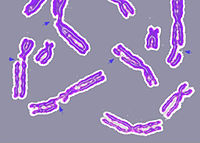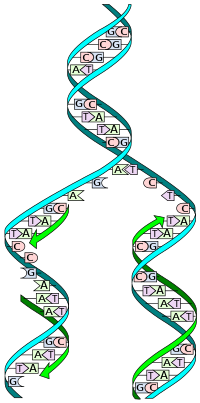
Genomic Studies Reveal New Aspects of the Biology of DNA Damaging Agents
Sign Up to like & getrecommendations! Published in 2017 at "ChemBioChem"
DOI: 10.1002/cbic.201700520
Abstract: A flurry of papers has appeared recently to force a rethinking of our understanding of how chemicals, light, and metal complexes damage our genomes. Conventional wisdom was that damaging agents were indiscriminate and it was… read more here.
Keywords: genomic studies; dna damaging; studies reveal; biology ... See more keywords

Cyclic AMP (cAMP) confers drug resistance against DNA damaging agents via PKAIA in CML cells
Sign Up to like & getrecommendations! Published in 2017 at "European Journal of Pharmacology"
DOI: 10.1016/j.ejphar.2016.11.043
Abstract: &NA; Cyclic adenosine monophosphate (cAMP) regulates many vital functions such as metabolism, proliferation, differentiation and death. Depending on cell types and stimulators, cAMP could either promote or attenuate cell death. cAMP signal can be transduced… read more here.
Keywords: cml cells; dna damaging; camp; damaging agents ... See more keywords

DNA damaging potential of Ganoderma lucidum extracts.
Sign Up to like & getrecommendations! Published in 2018 at "Journal of ethnopharmacology"
DOI: 10.1016/j.jep.2018.02.005
Abstract: ETHNOPHARMACOLOGICAL RELEVANCE Ganoderma lucidum (Lingzhi or Reishi) is a medicinal mushroom historically used in Asian countries to treat a wide variety of diseases and prolong life. In the last years, G. lucidum has been internationally… read more here.
Keywords: dna damaging; damaging potential; lucidum; ganoderma lucidum ... See more keywords

Synergistic Effects of an Irreversible DNA Polymerase Inhibitor and DNA Damaging Agents on HeLa Cells.
Sign Up to like & getrecommendations! Published in 2017 at "ACS chemical biology"
DOI: 10.1021/acschembio.7b00259
Abstract: DNA repair is vital to maintaining genome integrity but thwarts the effects of cytotoxic agents that target nucleic acids. Consequently, repair enzymes are potential targets for molecules that modulate cell function and anticancer therapeutics. DNA… read more here.
Keywords: dna damaging; inhibitor; dna; dna polymerase ... See more keywords

Detecting Attomolar DNA-Damaging Anticancer Drug Activity in Cell Lysates with Electrochemical DNA Devices.
Sign Up to like & getrecommendations! Published in 2021 at "ACS sensors"
DOI: 10.1021/acssensors.1c00365
Abstract: Here, we utilize electrochemical DNA devices to quantify and understand the cancer-specific DNA-damaging activity of an emerging drug in cellular lysates at femtomolar and attomolar concentrations. Isobutyl-deoxynyboquinone (IB-DNQ), a potent and tumor-selective NAD(P)H quinone oxidoreductase… read more here.
Keywords: dna devices; dna damaging; dna; electrochemical dna ... See more keywords

Click and Cut: a click chemistry approach to developing oxidative DNA damaging agents
Sign Up to like & getrecommendations! Published in 2021 at "Nucleic Acids Research"
DOI: 10.1093/nar/gkab817
Abstract: Abstract Metallodrugs provide important first-line treatment against various forms of human cancer. To overcome chemotherapeutic resistance and widen treatment possibilities, new agents with improved or alternative modes of action are highly sought after. Here, we… read more here.
Keywords: dna damaging; click chemistry; dna; chemistry ... See more keywords

Noncanonical NF-κB factor p100/p52 regulates homologous recombination and modulates sensitivity to DNA-damaging therapy
Sign Up to like & getrecommendations! Published in 2022 at "Nucleic Acids Research"
DOI: 10.1093/nar/gkac491
Abstract: Abstract Homologous recombination (HR) serves multiple roles in DNA repair that are essential for maintaining genomic stability, including double-strand DNA break (DSB) repair. The central HR protein, RAD51, is frequently overexpressed in human malignancies, thereby… read more here.
Keywords: dna; p100 p52; homologous recombination; dna damaging ... See more keywords

Greedy reduction of Bacillus subtilis genome yields emergent phenotypes of high resistance to a DNA damaging agent and low evolvability
Sign Up to like & getrecommendations! Published in 2023 at "Nucleic Acids Research"
DOI: 10.1093/nar/gkad145
Abstract: Abstract Genome-scale engineering enables rational removal of dispensable genes in chassis genomes. Deviating from this approach, we applied greedy accumulation of deletions of large dispensable regions in the Bacillus subtilis genome, yielding a library of… read more here.
Keywords: evolvability; subtilis genome; bacillus subtilis; high resistance ... See more keywords

A germline FANCA alteration that is associated with increased sensitivity to DNA damaging agents
Sign Up to like & getrecommendations! Published in 2017 at "Cold Spring Harbor Molecular Case Studies"
DOI: 10.1101/mcs.a001487
Abstract: Defects in genes involved in DNA damage repair (DDR) pathway are emerging as novel biomarkers and targets for new prostate cancer drug therapies. A previous report revealed an association between an exceptional response to cisplatin… read more here.
Keywords: dna damaging; increased sensitivity; germline fanca; sensitivity dna ... See more keywords

Azithromycin enhances the cytotoxicity of DNA‐damaging drugs via lysosomal membrane permeabilization in lung cancer cells
Sign Up to like & getrecommendations! Published in 2021 at "Cancer Science"
DOI: 10.1111/cas.14992
Abstract: Cancer cells use autophagy for growth, survival, and cytoprotection from chemotherapy. Therefore, autophagy inhibitors appear to be good candidates for cancer treatment. Our group previously reported that macrolide antibiotics, especially azithromycin (AZM), have potent autophagy… read more here.
Keywords: damaging drugs; dna damaging; treatment; lysosomal membrane ... See more keywords

A Peptide Derived from GAPDH Enhances Resistance to DNA Damage in Saccharomyces cerevisiae Cells
Sign Up to like & getrecommendations! Published in 2021 at "Applied and Environmental Microbiology"
DOI: 10.1128/aem.02194-21
Abstract: Many studies have shown that microorganisms, including bacteria and yeast, display increased tolerance to stress after exposure to the same stressor. However, the mechanism remains unknown. ABSTRACT Social behaviors do not exist only in higher… read more here.
Keywords: dna; dna damaging; yeast cells; stress ... See more keywords